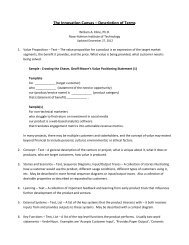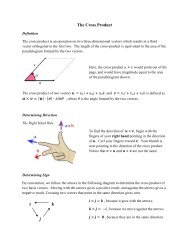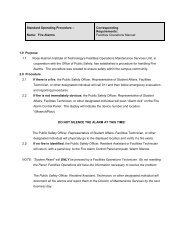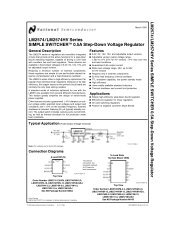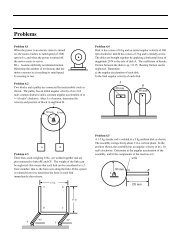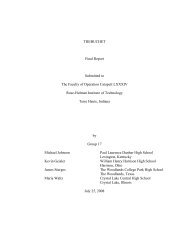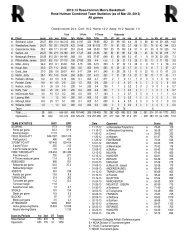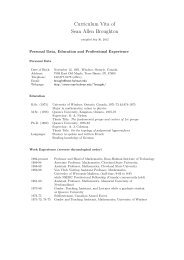21 Photosynthesis (Carbon Assimilation) The light ... - Rose-Hulman
21 Photosynthesis (Carbon Assimilation) The light ... - Rose-Hulman
21 Photosynthesis (Carbon Assimilation) The light ... - Rose-Hulman
You also want an ePaper? Increase the reach of your titles
YUMPU automatically turns print PDFs into web optimized ePapers that Google loves.
glyceraldehyde-3-phosphate using energy obtained from the <strong>light</strong> reactions of<br />
photosynthesis. <strong>The</strong> glyceraldehyde-3-phosphate has several possible fates;<br />
however, the continuation of the carbon fixation process requires regenerating the<br />
ribulose-1,5-bisphosphate starting material. <strong>The</strong> cycle thus has three phases:<br />
carbon fixation, glyceraldehyde-3-phosphate formation and ribulose-1,5-<br />
bisphosphate regeneration.<br />
Rubisco<br />
<strong>The</strong> rate-limiting enzyme in the Calvin cycle is ribulose 1,5-bisphosphate<br />
carboxylase/oxygenase (better known as rubisco). In most plants, rubisco is a<br />
complex of 8 large (53 kDa) and 8 small (14 kDa) subunits ( 8 8 ). <strong>The</strong> large subunit<br />
is coded by a chloroplast gene, while the small subunit gene is located in the<br />
nucleus. In photosynthetic bacteria, rubisco is usually a dimer of proteins<br />
homologous to the plant large subunit.<br />
Rubisco is an intensively studied protein, because it is one of the most important<br />
enzymes in existence. Rubisco is present at a concentration of ~250 mg/ml in the<br />
chloroplast stroma, comprising ~50% of the total chloroplast protein. Plants<br />
production of rubisco exceeds that of any other enzyme, and probably any other<br />
protein, on earth. Current estimates suggest that the biosphere contains ~10 kg of<br />
rubisco per human (this works out to about 0.02 moles of the enzyme per person).<br />
This tremendous amount of protein is necessary because the catalytic efficiency of<br />
rubisco is fairly low: it has a k cat of 1 to 3 sec -1 , and a rather low affinity for carbon<br />
dioxide. It is also necessary because rubisco catalyzes the wasteful oxygenase side<br />
reaction (discussed later); fixing sufficient carbon to support growth requires large<br />
amounts of this enzyme.<br />
<strong>The</strong> rubisco reaction is moderately complex. <strong>The</strong> general reaction mechanism is<br />
shown below.<br />
O<br />
H<br />
H<br />
O<br />
H 2 C<br />
C<br />
C<br />
C<br />
H 2 C<br />
O<br />
O<br />
P<br />
O<br />
OH<br />
OH<br />
O<br />
P<br />
O<br />
O<br />
O<br />
Ribulose<br />
1,5-bisphosphate<br />
H<br />
O<br />
H<br />
O<br />
H 2 C<br />
C<br />
C<br />
C<br />
H 2 C<br />
O<br />
O<br />
P<br />
O<br />
OH<br />
OH<br />
O<br />
P<br />
O<br />
O<br />
O<br />
Enediol<br />
intermediate<br />
H<br />
+<br />
O C O<br />
O<br />
O<br />
H 2 C O<br />
O P O<br />
O P O<br />
H C OH<br />
H 2 C O<br />
H 2 O<br />
H 2 C O<br />
C O<br />
O<br />
O<br />
HO C C HO C C<br />
O<br />
O O 3-Phosphoglycerate<br />
C O<br />
HO C OH<br />
H C OH<br />
H C OH<br />
O<br />
H 2 C O<br />
H 2 C O<br />
C O<br />
O<br />
P<br />
O<br />
O<br />
-Ketoacid<br />
intermediate<br />
O<br />
P<br />
O<br />
O<br />
Hydrated<br />
intermediate<br />
H<br />
C<br />
H 2 C<br />
O<br />
OH<br />
O<br />
P<br />
O<br />
O<br />
3-Phosphoglycerate<br />
<strong>The</strong> enzyme has a basic residue that abstracts a proton from the 3-position carbon<br />
of the ribulose-1,5-bisphosphate substrate, producing the enzyme-bound ene-diol<br />
intermediate. <strong>The</strong> ene-diol acts as the carbon dioxide acceptor, with the carbon<br />
dioxide molecule forming a bond to the 2-position carbon. <strong>The</strong> six-carbon -ketoacid<br />
intermediate is then attacked by a water molecule, resulting in cleavage of the bond<br />
between the former 2-position and 3-position carbons of the ribulose-1,5-<br />
O<br />
O<br />
P<br />
O<br />
Copyright © 2010-2011 by Mark Brandt, Ph.D.<br />
22





